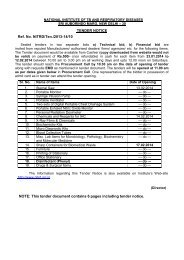The Indian Journal of Tuberculosis - LRS Institute of Tuberculosis ...
The Indian Journal of Tuberculosis - LRS Institute of Tuberculosis ...
The Indian Journal of Tuberculosis - LRS Institute of Tuberculosis ...
You also want an ePaper? Increase the reach of your titles
YUMPU automatically turns print PDFs into web optimized ePapers that Google loves.
124<br />
P.G. GOPI ET AL<br />
by Senior Treatment Laboratory Supervisor (STLS)<br />
and Senior <strong>Tuberculosis</strong> Supervisor (STS), two key<br />
personnel performing supervision on a daily basis,<br />
assisted by other health workers in the TU. MOTC<br />
conducts supervisory visits at least seven days in a<br />
month and supervises the functioning <strong>of</strong> the HFs in<br />
the TU. At each HF, a Medical Officer (MO) is incharge<br />
<strong>of</strong> programme implementation and monitoring<br />
by regular supervisory visits and review meetings.<br />
<strong>The</strong> ultimate aim <strong>of</strong> this programme is to cure the<br />
patients and cut the chain <strong>of</strong> transmission for the<br />
control <strong>of</strong> TB.<br />
Government <strong>of</strong> Tamil Nadu implemented the<br />
DOTS programme in a semi-urban population in<br />
Tiruvallur district in 1999 and TB Research Centre<br />
monitored the programme in one TU intensively for<br />
a period <strong>of</strong> 5 years since its implementation. We have<br />
undertaken several operational studies on various key<br />
aspects <strong>of</strong> DOTS strategy with a view to improving<br />
the performance and documented valuable<br />
information. However, the administrative and<br />
technical challenges have not been addressed so far.<br />
This paper describes the performance <strong>of</strong> the<br />
DOTS programme in different governmental HFs<br />
as measured by programme indicators. Even though,<br />
the conversion and cure rates are the outcome <strong>of</strong><br />
many factors, we have attempted to correlate them<br />
with the performance <strong>of</strong> the HFs.<br />
MATERIAL AND METHODS<br />
<strong>The</strong> study area is a semi-urban population<br />
<strong>of</strong> Tiruvallur district where the RNTCP was<br />
introduced in 1999. <strong>The</strong>re are 17 governmental HFs<br />
catering to the health needs <strong>of</strong> an estimated population<br />
<strong>of</strong> 5,80,000 spread over 209 villages and nine urban<br />
clusters. Of these, seven <strong>of</strong>fer microscopic facilities<br />
for diagnosis <strong>of</strong> TB. <strong>The</strong> study area has been divided<br />
into 5 blocks (these are five Panchayat Unions divided<br />
into five blocks for revenue and administrative<br />
purposes by the State Government), each block<br />
having 3-4 HFs. Subjects reporting voluntarily with<br />
cough <strong>of</strong> three weeks or more were investigated using<br />
sputum microscopy and those who were diagnosed<br />
were treated as per RNTCP guidelines 4 . <strong>The</strong> study<br />
subjects included all new smear positive TB patients<br />
who were registered under RNTCP at one <strong>of</strong> the<br />
above HFs from May 1999 to December 2003. <strong>The</strong><br />
standard definitions were used for disease<br />
classification and programme indicators like<br />
conversion and treatment outcomes 5 .<br />
Data collection<br />
Data on the initial results <strong>of</strong> sputum,<br />
classification <strong>of</strong> disease, follow-up smear results and<br />
treatment outcome were collected from the TB<br />
register maintained by the TU. After obtaining<br />
permission from the concerned state authorities, a<br />
field supervisor visited all the 17 HFs and collected<br />
the following data: leave and transfer particulars <strong>of</strong><br />
MO, Village Health Nurse/Health Inspector (VHN/<br />
HI), Laboratory Technician (LT) and Pharmacist;<br />
the number <strong>of</strong> supervisory visits to field, number <strong>of</strong><br />
review meetings held by verifying the relevant<br />
registers, holding health and other camps and<br />
occurrence <strong>of</strong> any social incidents like community<br />
clash or riots that might have affected the<br />
performance <strong>of</strong> HF activities during the period 1999-<br />
2003.<br />
Data analysis<br />
All data were computerized, edited and<br />
corrected for missing information. <strong>The</strong> overall<br />
conversion and cure rates were estimated and<br />
compared over the period 1999-2003. We compared<br />
the functioning <strong>of</strong> the HFs in each block with the<br />
programme indicators namely, conversion and cure.<br />
<strong>The</strong>se indicators were further looked into for each<br />
block and the HFs with a poor performance <strong>of</strong> DOTS<br />
in terms <strong>of</strong> conversion and cure rates were identified<br />
and the possible explanation for the same was<br />
explored, identified and discussed.<br />
Functional score<br />
We designed a scoring system to evaluate<br />
the programme performance vis-à-vis the score for<br />
each HF year-wise. A score <strong>of</strong> ‘1’ (otherwise ‘0’)<br />
was given for each <strong>of</strong> the eleven parameters assessed<br />
as given below: Availability <strong>of</strong> (1) MO, (2) MOTC,<br />
(3) LT, (4) Pharmacist, (5) conducted review<br />
meeting, supervisory field visits by (6) MO, (7)<br />
<strong>Indian</strong> <strong>Journal</strong> <strong>of</strong> <strong>Tuberculosis</strong>
















